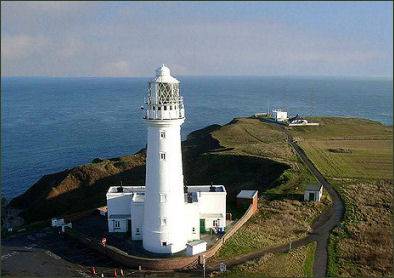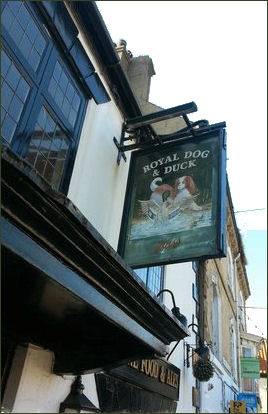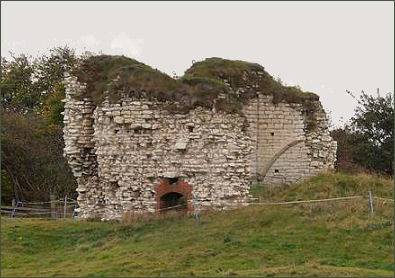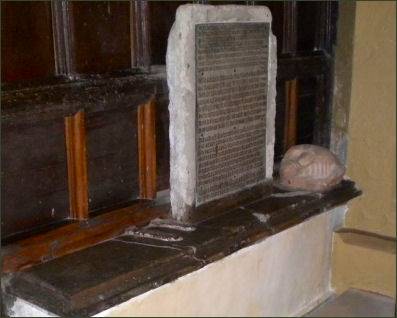Flamborough
OS grid reference:- TA 226 704
 The coastal village of Flamborough stands on the prominent headland of Flamborough Head, with its rugged white cliffs, the highest cliffs on the East Coast. The village lies around 4 miles (6 km) to the north-east of the popular coastal resort town of Bridlington.
The coastal village of Flamborough stands on the prominent headland of Flamborough Head, with its rugged white cliffs, the highest cliffs on the East Coast. The village lies around 4 miles (6 km) to the north-east of the popular coastal resort town of Bridlington.
Flamborough village is thought to have been originally settled over 1,100 years ago by Vikings, it is mentioned as "Fleneburg" in the Domesday Survey of 1086.
 Prior to this, there was a Roman presence, which is evidenced by Beacon Hill, once the site of a Roman signal station. The village is cut off by the enormous defensive earthwork of Danes Dyke which was dug in the Iron Age and divides the Flamborough Head peninsula from the mainland. The Dyke runs for 4km (about 2.5 miles) from the Danes Dyke Nature Reserve in the south to Cat Nab on the Bempton Cliffs in the north.
Prior to this, there was a Roman presence, which is evidenced by Beacon Hill, once the site of a Roman signal station. The village is cut off by the enormous defensive earthwork of Danes Dyke which was dug in the Iron Age and divides the Flamborough Head peninsula from the mainland. The Dyke runs for 4km (about 2.5 miles) from the Danes Dyke Nature Reserve in the south to Cat Nab on the Bempton Cliffs in the north.
Fishing was first recorded at Flamborough in the thirteenth century, when about nine boats fished the seas off the Head. By the 1890s, some eighty "cobles" were registered. Now, although some fishing is still carried on, the village relies to a greater extent on tourism.
Flamborough is a very popular holiday destination, the quaint whitewashed stone cottages and ancient church of St Oswald's lend great appeal to the village. Flamborough contains a number of shops and pubs, including the Rose and Crown and the Royal Dog and Duck which stands in the quaintly named Dog and Duck Square. holiday camps such as Thornwick and Sea Farm Holiday Centre and a caravan park.
 The ruins of Flamborough Castle (pictured left)
are situated in a field off Tower Street. The castle was actually a fortified manor house, which was constructed by Marmaduke Constable in 1351. Constable, received a licence to crenellate from the King Edward III.
The ruins of Flamborough Castle (pictured left)
are situated in a field off Tower Street. The castle was actually a fortified manor house, which was constructed by Marmaduke Constable in 1351. Constable, received a licence to crenellate from the King Edward III.
In 1537, the complex is said to have included a tower, a hall, a 'great parlour', a 'lord's parlour', a chapel, a court house, a mill house, and a great barn. The original defences included a clay rampart; which was later strengthened with a chalk curtain wall. Only the outlines have survived of these outer defences, which are visible as bumps in the field. At the centre of these defences stood a chalk pele tower. The tower still survives to first floor level on three sides. Records indicate that Flamborough Castle was the seat of the Constable family for centuries, until the death of Sir Robert Constable in 1537.
A lighthouse was first built on the Flamborough Headland in 1669 but was never lit. The current lighthouse was built in 1806 and acts as a waypoint for deep sea vessels and coastal traffic as well as marking the Flamborough Headland for vessels heading for the ports of Scarborough and Bridlington. Tours of Flamborough Lighthouse are organised by East Riding of Yorkshire Council under licence from the Corporation of Trinity House.
A walk along the shore or the back lane from Flamborough leads the visitor to Bempton Cliffs Nature Reserve, a nationally important breeding site for the seabirds. Fishing trips are also run regularly from the village.
St Oswald's Church
St Oswald's Church, which stands at the west end of Flamborough village, was founded in Norman times. The first written record of the church occurs in 1150, when it was granted to Bridlington Priory by William FitzNigel. A south aisle was added around 1200, and a north aisle around 50 years later. The Norman piers were later replaced by Early English arches and piers. The Lady Chapel, on the south side of the chancel, contains monuments to members of the Strickland and Ogle families, local landowners. The Chapel is enclosed by a beautifully carved parclose screen which dates to the fifteenth century.
The interior of the building contains a number of interesting historical features:-
 In the chancel, situated to the left of the altar is the tomb of Sir Marmaduke Constable (circa 1456/7 – 1518), the eldest son and heir of Sir Robert Constable ( 1423 - 1488) of Flamborough,. Sir Marmaduke served under three kings, Richard III, Henry VII and VIII. Sir Marmaduke served as a knight of the body to King Richard III, who granted him forfeited lands after Buckingham's rebellion. On 28 March 1484 the King granted him the constableship of Tutbury Castle. He fought in France and Scotland, and was commended by Henry VIII for his courage against the Scots at the Battle of Flodden in 1513.
In the chancel, situated to the left of the altar is the tomb of Sir Marmaduke Constable (circa 1456/7 – 1518), the eldest son and heir of Sir Robert Constable ( 1423 - 1488) of Flamborough,. Sir Marmaduke served under three kings, Richard III, Henry VII and VIII. Sir Marmaduke served as a knight of the body to King Richard III, who granted him forfeited lands after Buckingham's rebellion. On 28 March 1484 the King granted him the constableship of Tutbury Castle. He fought in France and Scotland, and was commended by Henry VIII for his courage against the Scots at the Battle of Flodden in 1513.
There is a rhyming epitaph describing his life and prowess on the tomb of Sir Marmaduke Constable, a fragment of a carved skeleton figure showing a curious lump on the chest. This is traditionally said to represent a toad, for legend records that Sir Marmaduke accidentally swallowed a toad while drinking water, and the toad ate at his heart until he died.
The Strickland Pardon is displayed in a frame on the west wall. It a royal pardon granted by King Charles II in 1660 to Walter Strickland, absolving him of high treason, Strickland had sided with Parliament against Charles' father during the Civil War and Commonwealth.
The font probably dates to the early Norman era and is attracttively carved with a design of interlaced diamonds. Below the chancel arch is a beautifully carved wooden rood screen. The screen is decorated with niches for statues which now have long gone.
Abbeys and Churches of Yorkshire
Towns and Villages of Yorkshire
